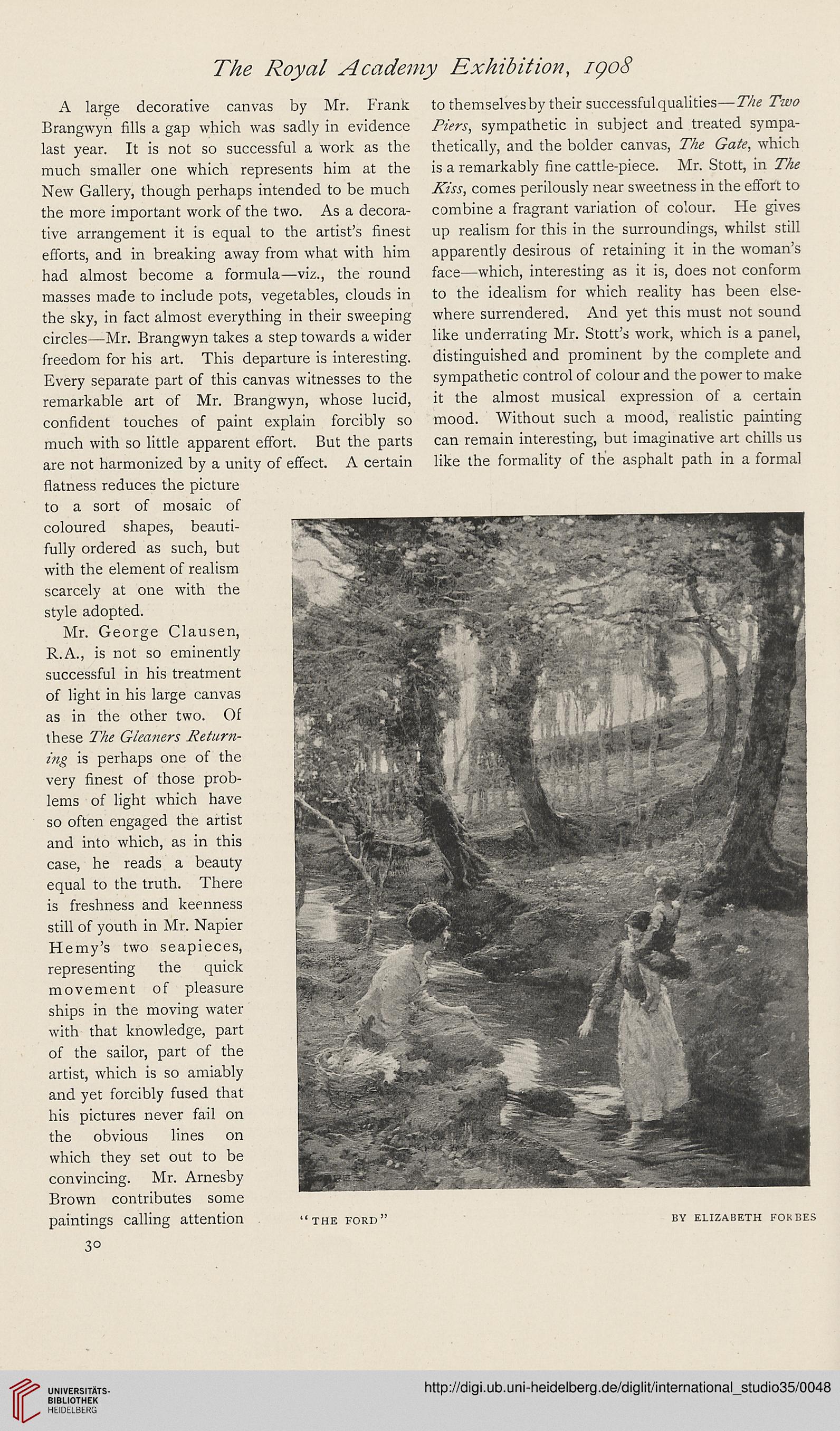The Royal Academy Exhibition, igo8
A large decorative canvas by Mr. Frank
Brangwyn fills a gap which was sadly in evidence
last year. It is not so successful a work as the
much smaller one which represents him at the
New Gallery, though perhaps intended to be much
the more important work of the two. As a decora-
tive arrangement it is equal to the artist’s finest
efforts, and in breaking away from what with him
had almost become a formula—viz., the round
masses made to include pots, vegetables, clouds in
the sky, in fact almost everything in their sweeping
circles—Mr. Brangwyn takes a step towards a wider
freedom for his art. This departure is interesting.
Every separate part of this canvas witnesses to the
remarkable art of Mr. Brangwyn, whose lucid,
confident touches of paint explain forcibly so
much with so little apparent effort. But the parts
are not harmonized by a unity of effect. A certain
flatness reduces the picture
to a sort of mosaic of
coloured shapes, beauti-
fully ordered as such, but
with the element of realism
scarcely at one with the
style adopted.
Mr. George Clausen,
R.A., is not so eminently
successful in his treatment
of light in his large canvas
as in the other two. Of
these The Gieatiers Return-
ing is perhaps one of the
very finest of those prob-
lems of light which have
so often engaged the artist
and into which, as in this
case, he reads a beauty
equal to the truth. There
is freshness and keenness
still of youth in Mr. Napier
Hemy’s two seapieces,
representing the quick
movement of pleasure
ships in the moving water
with that knowledge, part
of the sailor, part of the
artist, which is so amiably
and yet forcibly fused that
his pictures never fail on
the obvious lines on
which they set out to be
convincing. Mr. Arnesby
Brown contributes some
paintings calling attention “the ford” by Elizabeth fokbes
to themselves by their successful qualities—The Two
Piers, sympathetic in subject and treated sympa-
thetically, and the bolder canvas, The Gate, which
is a remarkably fine cattle-piece. Mr. Stott, in The
Kiss, comes perilously near sweetness in the effort to
combine a fragrant variation of colour. He gives
up realism for this in the surroundings, whilst still
apparently desirous of retaining it in the woman’s
face—which, interesting as it is, does not conform
to the idealism for which reality has been else-
where surrendered. And yet this must not sound
like underrating Mr. Stott’s work, which is a panel,
distinguished and prominent by the complete and
sympathetic control of colour and the power to make
it the almost musical expression of a certain
mood. Without such a mood, realistic painting
can remain interesting, but imaginative art chills us
like the formality of the asphalt path in a formal
3°
A large decorative canvas by Mr. Frank
Brangwyn fills a gap which was sadly in evidence
last year. It is not so successful a work as the
much smaller one which represents him at the
New Gallery, though perhaps intended to be much
the more important work of the two. As a decora-
tive arrangement it is equal to the artist’s finest
efforts, and in breaking away from what with him
had almost become a formula—viz., the round
masses made to include pots, vegetables, clouds in
the sky, in fact almost everything in their sweeping
circles—Mr. Brangwyn takes a step towards a wider
freedom for his art. This departure is interesting.
Every separate part of this canvas witnesses to the
remarkable art of Mr. Brangwyn, whose lucid,
confident touches of paint explain forcibly so
much with so little apparent effort. But the parts
are not harmonized by a unity of effect. A certain
flatness reduces the picture
to a sort of mosaic of
coloured shapes, beauti-
fully ordered as such, but
with the element of realism
scarcely at one with the
style adopted.
Mr. George Clausen,
R.A., is not so eminently
successful in his treatment
of light in his large canvas
as in the other two. Of
these The Gieatiers Return-
ing is perhaps one of the
very finest of those prob-
lems of light which have
so often engaged the artist
and into which, as in this
case, he reads a beauty
equal to the truth. There
is freshness and keenness
still of youth in Mr. Napier
Hemy’s two seapieces,
representing the quick
movement of pleasure
ships in the moving water
with that knowledge, part
of the sailor, part of the
artist, which is so amiably
and yet forcibly fused that
his pictures never fail on
the obvious lines on
which they set out to be
convincing. Mr. Arnesby
Brown contributes some
paintings calling attention “the ford” by Elizabeth fokbes
to themselves by their successful qualities—The Two
Piers, sympathetic in subject and treated sympa-
thetically, and the bolder canvas, The Gate, which
is a remarkably fine cattle-piece. Mr. Stott, in The
Kiss, comes perilously near sweetness in the effort to
combine a fragrant variation of colour. He gives
up realism for this in the surroundings, whilst still
apparently desirous of retaining it in the woman’s
face—which, interesting as it is, does not conform
to the idealism for which reality has been else-
where surrendered. And yet this must not sound
like underrating Mr. Stott’s work, which is a panel,
distinguished and prominent by the complete and
sympathetic control of colour and the power to make
it the almost musical expression of a certain
mood. Without such a mood, realistic painting
can remain interesting, but imaginative art chills us
like the formality of the asphalt path in a formal
3°




